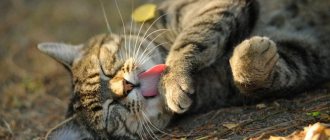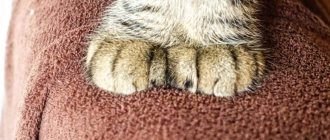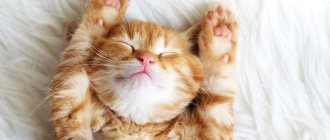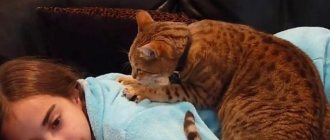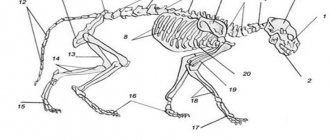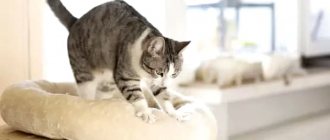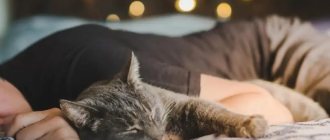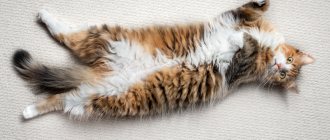Mechanism of sound occurrence
Why are the mechanics of a cat's purr still so poorly understood? The fact is that it is possible to determine for certain what and how cats purr only by dissection. But, of course, the dead don’t sing any “songs.” And modern diagnostic methods do not allow us to determine the origin of sounds.
It is known that there is no special organ for chirping sounds. This process definitely involves the vocal cords, the lungs, since “mur” sounds rhythmically, on inhalation and exhalation, and, possibly, the diaphragmatic and intercostal muscles. And - absolutely - the brain.
A cat's purring is a complex process that involves the lungs, muscles and brain.
Most researchers believe that cats purr through their throats. The vocal cords contract and the sound passing through them vibrates with each inhalation and exhalation. But what makes a cat do this? Question for neurophysiology. The “motor” is started by a mechanism in the brain.
Interesting fact: the comparison of a purring cat with a tractor is not accidental. At idle the car produces the same 15–150 Hz. Owners note that female cats purr louder than male cats.
There are alternative theories of the origin of uterine sounds:
- This is the sound of blood moving through the inferior vena cava, which carries venous blood to the heart.
- This is what the hyoid bones do.
- There are false vocal cords that are responsible only for these sounds.
- It was previously believed that vibrating sounds originated from the abdomen. But anyone who has petted a cat knows that this is not the case.
For now, the neurophysiological theory prevails: the need to vocalize breathing arises in the brain, and it already gives the command to the vocal cords. We hope that scientists will soon test the hypothesis and the age-old mystery will be revealed. In the meantime, let's figure out what causes the cat's brain to signal to the ligaments.
Most often, cats purr in a relaxed state, for example, on the owner's lap.
Cat-human interaction
The way a cat purrs depends on the person. A purring pet can trample its paws on its owner, lie down on top or next to it. All these actions have their explanation.
Showing affection
If you stroke your mustachioed pet, he will soon begin to purr. This means that he enjoys touch and communication with a person. When stroking against the grain or by a stranger, you can see the opposite effect. The animal will be angry or frightened and will hasten to leave with a threatening hiss.
Foot trampling
The most popular interpretation of trampling is the “milk step”. Kittens make similar movements on their mother's chest, stimulating the faster production of milk. Fingering with paws is also associated with:
- showing gratitude and demonstrating trust in a person;
- unrealized sexual instinct in castrated animals;
- treating the owner or relieving one’s own stress;
- preparing a comfortable place to sleep.
If your pet releases its claws when trampling, do not scold it. He does not control this action, so pet him and place a thick blanket or pillow under his paws.
Lying on or next to a person
Lying nearby is the highest form of trust and love. The animal feels safe with its two-legged owner. If a person is unwell, a furry pet can lie on top, sending its healing vibrations to the sore spot.
What does a cat's purring mean?
Previously, it was believed that this is how animals communicate with each other and humans when they are stroked. However, “mur-mur-mur” is not only a means of communication and a way to express pleasure.
Method of communication
Kittens begin to purr already in the first days after birth. This is how they help mom find herself and feed her. With a person, everything works about the same. Animals wake people up, butt and purr loudly in the morning, especially if they spend the night in another room. “Good morning, master! It’s time to get up and feed me.” If your pet loudly “sings songs” in the kitchen (or where you usually feed your pet) and curls under your feet, meowing periodically, this is a direct hint of a desire to snack.
Surely you have noticed more than once that pets greet you stormily from work. At this moment, you can also hear a joyful “mrrr”.
Purring, the cat greets its human.
In relation to relatives, everything works exactly the same: a quiet sound indicates location. He warns others about a benevolent and good-natured attitude. This is also how animals encourage each other. Some scientists have noticed that wounded cats lie down next to each other.
Expression of pleasure
A satisfied cat - what could be more pleasant for the owner? Pets can actually express pleasure and even gratitude from tasty food, a secluded bed and warmth. Many pets love affection, and with the help of purring they express pleasure from stroking and scratching.
In combination with paw stomping, purring indicates peace and love. This means that your pet completely trusts you, is happy and feels as calm as she does next to her mother. After all, kittens’ little paws make “massage” movements to get more milk. Apparently, the memory remains with the animal forever, and pops up in moments of good mood. And besides, in this way the cat “marks” the owner.
Connection with nutrition
Remember that a kitten purrs so that the cat notices and feeds it? Echoes of this mechanism can be seen in the fact that many animals rumble when they eat. Perhaps from pleasure. Especially if it is SUPERPET - a species-typical food for cats and dogs according to the BARF system, developed by veterinarians and nutritionists. It replicates the diet of predators in nature: 98% consists of raw meat without heat treatment, flavor enhancers and preservatives. Biologically appropriate nutrition normalizes digestion, prevents urolithiasis, kidney disease and other ailments. And how delicious it is! Pets can only purr with pleasure.
For what reasons does a cat purr?
When answering why cats purr, many owners confidently say that the reason lies in positive emotions. This answer is correct, but incomplete. Sometimes purring is also triggered by negative emotions. You can only understand your pet's desires over time by remembering the difference in volume, duration and frequency of sounds.
Positive emotions
The ability to make a vibrating sound appears in kittens on the 2nd day after birth.
This is necessary to communicate with the mother. The purring of the babies indicates their satiety and good health, and the sounds emanating from the mother cat confirm the safety of her offspring.
In the wild, light vibrations are not detected by other predators, but are clearly perceptible to parents located at a long distance. This helps protect the litter until it becomes independent.
Among the positive emotions that awaken purring are:
- greeting the owner or communicating with other animals;
- going to bed before bed;
- gratitude for the treat or affection received;
- attracting the opposite sex;
- trying to beg for something tasty;
- interest in some object (delicious food) or object (a bird outside the window).
According to one version, cats purr to prevent muscle diseases that threaten them due to too much sleep. Vibrations spreading throughout the body have a positive effect on ligaments, bones and muscles, helping to reduce the load on the musculoskeletal system.
Negative emotions
Purring also occurs when a furry pet is under stress. The vibrations help him stabilize his blood pressure and bring his pulse back to normal.
Sometimes the reason lies in illness. Purring is a physiological pain reliever. It speeds up metabolism and promotes rapid regeneration. Try to observe how a cat purrs after sterilization: the frequency and volume of the sound will differ from usual until the end of rehabilitation.
One of the possible complications of coronavirus infection is feline infectious peritonitis. Its alternative name is “purring disease.” Due to damage to the blood vessels, some of the fluid enters the peritoneum and lungs, causing peritonitis. The bloating that appears is accompanied by a characteristic purring sound.
Also, mustachioed pets purr when their owner strokes them incorrectly or when a more formidable opponent tries to scare them. In the second case, they demonstrate their defenselessness, trying to avoid a possible fight.
Food for adult cats and kittens
Start shopping
Stress and pain
Cats begin to make purring sounds in different situations. It can be very stressful - right after having to run away from the dog. Or weak - when examining a new room. By purring, pets calm not only humans, but also themselves. Rhythmic sounds are a great way to relax.
There is a hypothesis that purring animals heal themselves. Vibration frequency from 20 to 150 Hz helps restore tissue, including bone, grow muscles, repair tendons and ease breathing. In their natural environment, animals have to sit in ambush for a long time when hunting and jump quickly, so it is important to maintain bone tissue in order.
Felines often purr when they fall asleep. It is possible that a large amount of sleep is also associated with the restoration of the body - up to 20 hours a day.
Loud purring for no apparent reason can be a signal to the owner that the cat is in pain. Especially if she sits with her eyes closed and her mustache drooping. Be careful: these animals endure pain until the last moment and hide their symptoms.
If a cat purrs in a tense position without closing its eyes, it is unlikely that it is feeling well at that moment.
During childbirth, cats also purr, helping themselves to overcome pain. Unfortunately, even before death, many of them make such sounds. Purring is very connected with physiological processes: appearing in the first days of life, it remains with the cat until the very last moments.
It is important to note that all cats are different, and they also vocalize their emotions differently. Some of them do not purr at all, while others trill constantly. And all these are variants of the norm. You can understand what your pet wants at the moment by her body language. A relaxed posture indicates pleasure, a tense one indicates that she wants something from you. An excited purr near a bowl is very different from what you hear when a furry dog curls up next to you.
When she gets what she wants, the purring stops. Think about the situations in which this happens and what the animal wants to tell you. Develop your powers of observation and you will be able to better understand your four-legged companion.
Where is the cat's urch located?
Rumbling is a low, continuous sound. Take a closer look at what the cat purrs. The process looks as if the purrs are emitting a characteristic belly rumble, but this is not the case. Sound originates in the apparatus between the base of the skull and tongue. Here is a group of thin hyoid bones. Contraction of the muscles of the cat's vocal cords leads to vibrations of the bones. Then the muscles of the larynx are connected, and our ear begins to catch the rumbling.
Citi Kitty cat toilet training system
Price: 720 rub. 1080 rub. 33% discount for you!
Trains in 3 weeks. Fast delivery throughout Russia. And also more than 3,000 other pet products at competitive prices! Take a look!
Urchalnik design
Scientists have spent a lot of effort to find out what a cat purrs with, what the design of the purr is, and where the purr is located. The pattern of the process of rumbling formation is similar to the reproduction of sounds by humans, with some differences. The algorithm for generating sounds in cats consists of the following actions:
- air from the lungs passes through the vocal cords into the larynx;
- vibrations cause resonance in the hyoid bone.
A person uses the tip of his tongue to produce vowels. Cats tense the muscles in their nasal sinuses and mouth. Tone appears in the throat and lips. Then sounds are formed. Cats produce consonants by changing resonance and opening their mouths.
Approximate diagram of a cat
Scheme for reproducing rumbling sounds
Purring is the result of vibrations and vibrations. But not everything is so simple. To the question: where is the cat’s urchin located, scientists have not given a definite answer. Let's consider other options for searching for the place where cats have a purr.
In search of the birthplace of vibrations, a group of scientists determined what makes a cat purr. In their opinion, it is the false cords that vibrate. Others prove that vibrations in the chest and throat are of a nature associated with blood circulation in the vessels. But most are inclined to argue that the purr is a structure made from the hyoid bones.
The question of where a cat’s urinal is located has been of interest for a long time. Rumbling is a property of all cats. Scientists studied how sounds are formed in other members of the family to find out where the cat’s purr is located.
Do big cats purr?
We have said more than once that the anatomy of a domestic cat is no different from the structure of a wild one. From a structural point of view, the gastrointestinal tract has not changed over millennia of evolution. What about neurophysiology and psychology?
Small cats - caracals, lynxes, cheetahs - purr like our domesticated pets. Although, of course, more often they hiss. Leopards, lions, panthers and tigers do not purr in the usual sense - they rather roar and make bass sounds. Their purr is more like a roar. But predators definitely use these techniques to communicate, when consuming food and expressing pleasure. There are videos online of cheetahs, tigers and pumas purring.
How purring occurs
The sound originates between the base of the skull and the base of the tongue. In the cat's brain, impulses arise that provoke contraction of the muscles near the vocal cords. The bones under the tongue create a vibration that spreads throughout the animal's body.
Their ability to purr depends on the structure of the hyoid bone of baleen animals. Domestic cats have a triangular-shaped bone, thanks to which they are able to purr continuously both when exhaling and inhaling. Large felines have a rectangular bone under the tongue. This allows them to make roaring sounds to intimidate and scare away enemies, but they can only rumble when exhaling.
Video with a visual demonstration of the anatomical causes of purring:
Many other animals make sounds similar to purring, such as guinea pigs, rabbits, raccoons and hyenas. But this cannot be called purring to the fullest extent. Only cats can truly do this.
Reference! While purring, it is impossible to listen to the animal's heart and lungs.
Why your cat doesn't purr and what to do about it
Is it possible to make a cat purr? No, especially if she is not naturally inclined to do this. And that's okay: not everyone feels the need to express emotions by purring. There are even breeds that are not inclined to turn on their “engines” - Ragdolls and Devon Rex. Here, again, there are exceptions.
Getting a purr to do anything is very difficult in general, and with purring and other ways of expressing emotions it is even more difficult. This partly explains the impossibility of accurately diagnosing the mechanics of the appearance of iridescent sounds in predators. Nobody wants to purr in an MRI machine or during an ultrasound.
Sometimes this “insensitivity” is related to previous negative experiences. If the cat has been with bad owners or on the street, it may simply be afraid to show emotions by purring. You can try to help your cat make the desired sounds. Play with her, caress her, introduce treats into her diet (always natural) and demonstrate by your behavior that you are a safe person.
Purring from the point of view of a physiological process
Cat owners, of course, were interested in where exactly such sounds, pleasant to the human ear, come from. There is a feeling that the rumbling is coming from the cat’s soft tummy, but everything is much more complicated.
In fact, the sound comes from the larynx and is formed using the muscles that are located near the vocal cords. This happens during breathing, both during inhalation and exit. But the question arises, how does a cat regulate its funny rumbling, because it breathes even during sleep, but does not make accompanying sounds.
It turns out that muscles begin to participate in the process only when an impulse is supplied from the brain. So, if an animal finds itself in one of the situations described above, the signal is transmitted to the muscles of the larynx. They begin to contract and a person hears a lovely sound when the cat inhales and exhales air.
The unrecognized loudness record holder is Bluey the cat from the UK. According to measurements, the purring reaches 93 dB. Simply put, the sound made by a pet is similar to the noise from a lawn mower. The record is not included in the Guinness Book of Records because the owners did not submit an official application.
The benefits of a cat's purring for humans
Our smaller furry brothers are real doctors. There is even feline therapy - treatment by communicating with cats. Pet owners cope better with stress, are less likely to become depressed, are more sociable and, in general, are healthier than people without pets. Why is purring useful?
Cats are furry physiotherapists. At a frequency of 25-50 Hz, bone tissue responds to purring, and at 100 Hz, skin and soft tissues respond. It's not as crazy as it may seem: the body's tissues respond to pressure by becoming stronger. Scientists even propose using this property of vibration for astronauts so that their bones do not lose their density in zero gravity.
A purring cat pleases the human heart. This means that having a pet in the home reduces the likelihood of having a stroke by a third. “Pur-mur-mur” is a kind of white noise, to which the owner calms down and falls asleep more easily.
Thus, not all purring kittens and cats are happy with their situation. A purring pet can feel both joy and pain. This amazing means of communication allows animals to communicate with each other and get what they want from humans. If a cat likes food or, conversely, is hungry, it will purr. This is done by domestic purrs, cheetahs, and pumas. But if your pet does not want to purr, this is also not a problem, and you can do nothing about it.
Beneficial effect for humans
A cat in the house is a real anti-stress. True lovers of furry animals get great pleasure from communicating with kittens and adult pets. An affectionate and playful cat perfectly adapts to the character of the owner and often helps to overcome difficult periods in life. But these are not all the beneficial properties of a furry friend:
- According to scientists, rumbling at a frequency of 27 to 44 Hz has a beneficial effect on the strength of human bone tissue;
- A number of nervous disorders, coupled with drug therapy, have more effective results when the patient comes into contact with a cat;
- The purring of a pet has a positive effect on the immune system;
- The sounds made by a cat improve blood circulation, and as a result normalize blood pressure and pulse;
- Doctors have noticed that purring helps drug and alcohol addicts survive the rehabilitation period;
- Pets that purr and lie on the owner treat problems with the gastrointestinal tract;
- Purring and extending claws on a person is equated to an acupuncture session. It has been proven that in this interesting way cats improve skin condition, relieve swelling and even lose weight;
- A child raised in a family with a cat from early childhood suffers less from allergies. This is explained by the fact that the allergens of a furry animal have a preventive effect. However, we are talking specifically about being with the pet from birth;
- The owners of tailed purrs live longer than people who do not have any animals, by 4.5 years.
The beneficial properties of tailed fish are successfully used by marketers in the catering industry. The first cat cafe appeared in Taiwan. Russia adopted useful experience only in 2011. In such establishments, people who cannot have a pet come and enjoy communication with “furry anti-stressers.”
